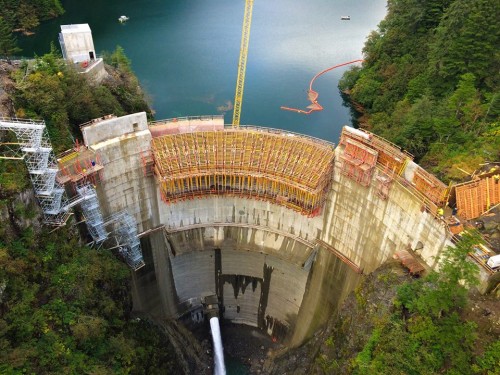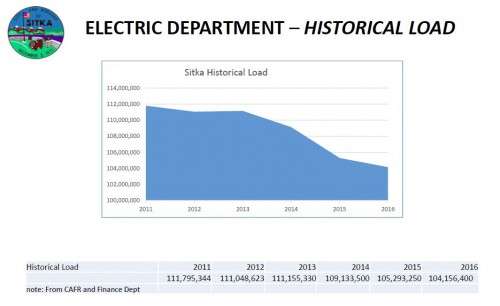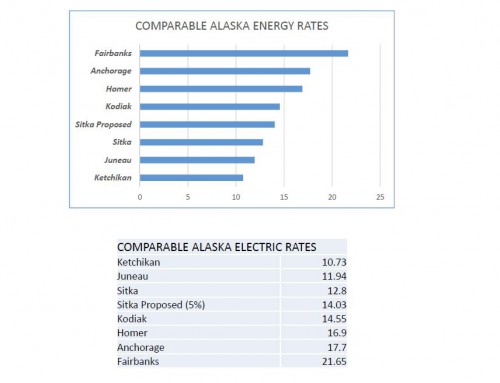
The city of Sitka is struggling to pay off the Blue Lake Dam in a big way. The project was largely funded through bond proceeds. But due to a major decline in electric usage by Sitka customers, the city doesn’t have enough money to meet the bond payment. This is true not only for this year, but in the coming year as well should electric usage in Sitka plateau and voters fail to approve a ballot question raising the mill rate.
Faced with this shortfall in the electric fund – which is nearly $3 million this year – the Sitka Assembly debated their options during a work session last night (09-27-16). To fix this, the Assembly plans to increase rates by another 5% this year and look to other funds to cover the rest.
On September 11th, 2012 and the Assembly was trying to decide whether to move ahead with the Blue Lake Dam expansion project. The bid exceeded its cost estimate by $40 million and during persons to be heard, the lone voice of dissent was former Mayor Marko Dapcevich.
“If you look at where the utility rates are going in this town, I think you’re going to find that the demand that you’re hoping from that dam is not going to be there. There will be less utility accounts, less people, less business, less a lot of things,” Dapcevich said.
Flash forward to today and that concern is shaking out to be true. All the decisions about the dam’s design – from the turbines to raising the wall by 80 feet – were predicated on an assumption that Sitka’s electrical demand would remain the same or increase.
Chief Administrative and Financial Officer Jay Sweeney and Utility Director Bryan Bertacchi walked the Assembly through the revenue crisis facing the electric department during Tuesday night’s meeting.
Jay Sweeney: The whole premise of the dam was based on the premise that there was going to be a continued demand at 110 million kwhr/year.
Bertacchi: And we’re actually at 104 million kwhr/year. A giant spread between where they thought they would be when they approved the dam and where we are today.
Projected Electric Load in Sitka (1973-2028)

Actual Electric Load in Sitka (2011-2016)

The drop in Sitka’s electric usage amounts is for a number of reasons. The winters have been warm. A lot of customers are going back to wood stoves or diesel power due to the falling price of fuel. But the result is that the city doesn’t have the money it thought it would to pay for the dam. The deficit within the electric fund is $2 to $3 million this year, which is far more than the city projected when it finalized its budget in the spring.
Now, the Assembly could raise rates to pay for it all. An increase by 20 or 22% would do it. But such a prospect did not sit well with them. Many at the table were worried that rate increase of 20% would drive customers to use even less electricity.
City Administrator Mark Gorman said, “We’re going to stimulate conservation, which pushes us deeper into the hole. It’s kind of a damned into if you do, damned if you don’t scenario.”
This is crux of the problem before the Assembly: If they raise rates too little, they risk defaulting on the bond agreement. If they raise rates too much, usage could nosedive even further.
“Mr. Brewton used to call that the utility death spiral,” remarked Deputy Mayor Matthew Hunter. Chris Brewton is the former Utility Director. Assemblyman Steven Eisenbeisz responded, “I feel we’ve jumped off that cliff already.” Both paused and took deep breaths. There were a lot of moments like this during Tuesday night’s meeting.
If the Assembly were to trim city government this year instead of raising rates, the cut would be $2 million. That option wasn’t palpable for Hunter, who said, “I don’t think that’s easy to do in a way that doesn’t drastically impact our citizens by services or personnel. I don’t know. This is an interesting…a very interesting problem. This isn’t going to be fun few years here guys.”
There’s two other pressure valves attached to this problem:
1) The bond agreement. Until 2030, Sitka can only pay interest on those bond proceeds for the Blue Lake Dam and the Jarvis Street Solar Turbine Project and they must do so exclusively with cash flow. The payment due this year is $10 million and it’s a deadline Sweeney said the city has to meet under these very specific constraints. “Until that point in time that you have to pay the specific amount of money, you have to pay interest payments on that. You can’t pay them early,” Sweeney said.
2) Parts of the city’s electrical infrastructure are in desperate need of repair. Bertacchi and his team have developed a 10-year-plan to do this (Memo Electric Department 10 Year Capital Plan). Top priorities include creating a backup for the Marine Street Substation – which supplies power to 80% of Sitka’s customers – and an overhaul of the Green Lake Power Plant. “The more we look at Green Lake, it’s the 1990s since it’s been overhauled. It’s a great facility. Huge value to this community. And we just can’t let it go without an overhaul in the next 10 year window,” Bertacchi said.
Taking all this in stride, the Assembly chose a more modest rate increase of 5% for this year. Their ordinance (Ord 2016-38)- passed unanimously on first reading – also eliminates the first residential tier for customers who use under 200 kwhr. Their bills would go up by $6. Furthermore, it increases the monthly harbor fee to pay for replacement marine grade meters and eliminates the city’s policy of putting hangers on people’s door knobs when they are delinquent on the bills.

The ordinance closes the gap in the electric fund somewhat, but the city is still short $1.3 million. And for that, the Assembly directed city staff to go looking elsewhere for that money before raising rates by 20%.
Eisenbeisz: I’m really not willing to throw a 20% increase on people right now, but without any other money coming in, we have no option. So, I think we need to do our due diligence in finding some other ways to fund this definitely.
Swanson: If we go with a rate increase right off the bat, we can just kiss that mill rate goodbye.
Swanson was referring to the next Tuesday’s ballot question, which would raise the cap on property taxes by 2 mills and consequently raise $1 million for the electric fund.
For their next meeting on October 11th, City Administrator Mark Gorman will talk about pockets the Assembly can draw from to save the electric fund. Those include the Southeast Economic Development Fund, the Permanent Fund, the Bulk Water Fee Fund.
None of these area ideal. The whole point of a fund is that it pays for itself. But that’s just not the reality when it comes to the electric utility in Sitka. The dam is built. It has to be paid for. The question is how.
Gorman said, “We’re entering kind of an emergency situation, a crisis situation, when it comes to managing our electric utility and the affordability of it. So we have to find ways of relieving that pressure on the citizens without compromising our economic integrity.”
It’s a crisis the Assembly wants to try to solve in-house before taxing citizens any further. They’ll meet next on October 11th in the new Harrigan Centennial Hall.




